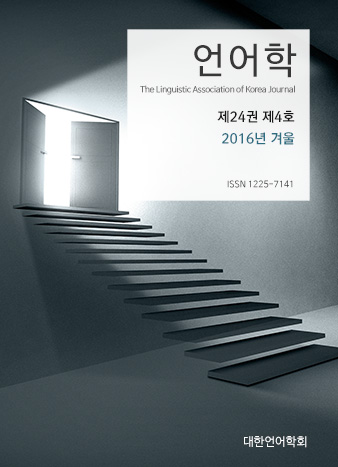대한언어학회 전자저널

-
An Alternative Approach to Realizations of the Medial [nt] Cluster in English
-
Boundary and pitch effects on the perception of Korean alveolar nasal
-
Corpus-Based English Grammar Instruction in a Korean College Context Korean College Context
-
A Study on the Relationship between Self-Efficacy Beliefs and Comprehension in English Reading
Abstract
Keywords
# 정도부사(degree adverbs) # ‘너무’(‘nemu’) # 공기어(collocate) # 코퍼스(corpus) # 격식담화(formal discourse) # 비격식담화(informal discourse) # 세종말뭉치(Sejong Corpus)
References
- 고혜원. (2011). 정도부사 ‘너무’의 의미와 공기 특성. 어문논집. 46. 121-139.
- 김혜영․강범모. (2010). 구어 속 강조적 정도부사의 사용과 의미. 한국어학. 48. 101-129.
- 김선희. (2001). 우리 사회 속의 우리말. 한국문화사.
- 박동근. (2007). 현대국어 강조부사 범주의 설정과 기능적 분석. 한글. 275. 한글학회. 129-163.
- 박형진. (2009). 부사 ‘너무’의 통시적 변화에 대하여. 국어학논집. 6. 97-114.
- 배진영. (2014). 구어와 문어 사용역에 따른 정도 부사의 분포와 사용 양상에 대한 연구. 국제어문. 54. 95-140.
- 백정민. (2009). ‘너무’의 통시적 연구. 국어학 논집. 6. 9-35
- 송지혜. (2014). 코퍼스 분석을 통한 정도부사의 빈도, 분포, 공기관계에 대한 연구. 연세대학교 대학원. 국내석사학위논문.
- 이석규. (1988). 현대국어 정도 어찌씨의 연구. 건국대학교 박사학위논몬. 10-16.
- 임규홍. (2002). 국어 정도부사 ‘너무’의 화용론적 의미. 배달말. 30. 배달말학회.
- 임규홍. (2004). 정도부사 ‘너무’의 어형성과 공기 특성. 우리말글. 32. 우리말글학회.
- 최홍열. (2005). 정도부사의 유의어 연구. 역락.
- 하효우. (2014). 한국어 정도부사 ‘너무’. 한중인문학회 국제학술대회. 229-235.
- 한영균․고은아. (2011). 유의적 정도부사의 빈도․분포․결합관계의 분석과 그 활용. 한국어 의미학. 35. 335-394.